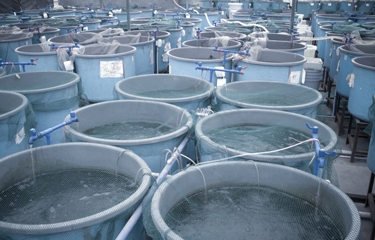The tide is turning for recirculating aquaculture systems (RAS) and this emerging technology has the potential to change the face of aquaculture over the next decade, claims a new report from Rabobank.
Analysis in the “Aquaculture 2.0: RAS Is Driving Change” report, compiled by RaboResearch Food & Agribusiness, states that while the “RAS concept is still under development and the future holds uncertainties,” the number of proposed projects to farm seafood species using this technology is increasing day by day, with the majority of ventures focused on salmon farming.
To date, more than 50 projects to farm salmon in land-based systems have been identified by Rabobank, with the total estimated production of these ventures up to 2030 being equivalent to 25 percent or 700,000 metric tons (MT) of the current total salmon production.
While this volume is unlikely to be reached in the next 10 years due to such limiting factors as financial bottlenecks, the wrong business or marketing strategy, the wrong choice of location or species to farm, postponements in permits – plus a number of proposed projects are unlikely to materialize – the banking multinational believes that RAS systems do have the potential to produce 250,000 MT within the time frame.
Authored by Beyhan de Jong, analyst – animal protein at Rabobank, the report confirms that the majority of land-based salmon farms are planned in Norway, and this is due to the know-how around salmon farming and the existing cold chain and logistics infrastructure in the region. However, the total proposed production volumes are highest in the United States, followed by China, and this is because of the high growth in demand in the regions.
One-third of the proposed RAS projects mapped target a production volume up to 5,000 MT by 2026 or at a later date. The majority of the projects aim for a production volume between 5,000 to 35,000 MT.
Among the relatively larger-scale projects, Atlantic Sapphire is planning the highest production volume in a single RAS facility so far, with 220,000 MT targeted for a facility in the United States. At the same time, Pure Salmon targets a global salmon volume of 260,000 MT, of which 100,000 MT is planned for China.
The report highlights that only a few projects are already harvesting salmon and showing early success. Others are at the financing stage, some are busy with getting permits, and some are constructing their facilities.
It said that despite the large volumes of planned production, current volumes coming from salmon farming with RAS are minor, at around 3,000 MT, with no company currently producing more than 1,000 MT.
Nevertheless, with the number of announced projects increasing from 30 to over 50 from 2018 to 2019, more than doubling the planned production volumes, the report suggests the pace of growth means it’s reasonable to expect more proposals to be added to the pipeline, which might increase planned volumes up to 1 million MT next year.
“RAS could be a disruptive aquaculture technology in the next 10 years – not only in terms of adding volumes to salmon production, but also by potentially disrupting trade flows, supply chains, and the marketing of salmon,” states the report. “Land-based salmon could almost be a mainstream product in the next decade if the proposed RAS salmon projects can more or less achieve their ambitious harvest levels and successfully produce a volume of around 500,000 MT.”
Rabobank also believes RAS operations manage to produce salmon at around NOK 40 (USD 4.36, EUR 3.93) to NOK 50 (USD 5.45, EUR 4.91), even with less-than-expected volumes of production, they can still create a niche.
The analysis maintains that another important element to factor in is geography, whereby a volume of less than 10 percent of the expected salmon production could sound relatively minor for large salmon producers like Norway and Chile, but the ability to locally farm salmon in regions such as China, where there is no local salmon production, could change current trade dynamics.
“There is a high chance that some of these projects will succeed if they have at least half of the key success factors regarding the species and location selection,” the report states. “The companies who achieve this will be the frontrunners in land-based aquaculture. RAS technology is here. The big questions are where and when mainstream land-based salmon production start – and who will start it.”
Photo courtesy of Shutterstock







